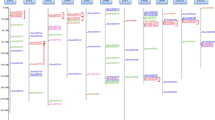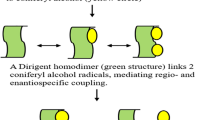Abstract
Glutathione acts as a protein disulphide reductant, which detoxifies herbicides by conjugation, either spontaneously or by the activity of one of a number of glutathione-S-transferases (GSTs), and regulates gene expression in response to environmental stress and pathogen attack. GSTs play roles in both normal cellular metabolisms as well as in the detoxification of a wide variety of xenobiotic compounds, and they have been intensively studied with regard to herbicide detoxification in plants. A newly discovered plant GST subclass has been implicated in numerous stress responses, including those arising from pathogen attack, oxidative stress and heavy-metal toxicity. In addition, plants GSTs play a role in the cellular response to auxins and during the normal metabolism of plant secondary products like anthocyanins and cinnamic acid. The present work involves two in silico analytical approaches—general secondary structure prediction studies of the proteins and detailed signature pattern studies of some selected GST classes in Arabdiopsis thaliana, mustard, maize and bread wheat by standard Bioinformatics tools; structure prediction tools; signature pattern tools; and the evolutionary trends were analyzed by ClustalW. For this purpose, sequences were obtained from standard databases. The work reveals that these proteins are mainly alpha helical in nature with specific signature pattern similar to phosphokinase C, tyrosine kinase and casein kinase II proteins, which are closely related to plant oxidative stress. This study aims to comprehend the relationship of GST gene family and plant oxidative stress with respect to certain specific conserved motifs, which may help in future studies for screening of biomodulators involved in plant stress metabolism.




Similar content being viewed by others
References
Hayes JD, Pulford DJ (1995) The glutathione S-transferase supergene family: regulation of GST and the contribution of the isoenzymes to cancer chemoprotection and drug resistance. Crit Rev Biochem Mol Biol 30(6):445–600
Edwards R, Dixon DP (2000) The role of glutathione transferases in herbicide metabolism. In: Cobb AH, Kirkwood RC (eds) Herbicides and their mechanisms of action. Sheffield, Sheffield Academic Press, pp 33–71
Wilce MCJ, Parker MW (1994) Structure and function of glutathione S-transferases. Biochim Biophys Acta 1205:1–18
Sheehan D, Meade G, Foley VM, Dowd CA (2001) Structure, function and evolution of glutathione transferases: implications for classification of non-mammalian members of an ancient enzyme superfamily. Biochem J 360:1–16
Pemble SE, Wardle AF, Taylor JB (1996) Glutathione S-transferase class kappa: characterization by the cloning of rat mitochondrial GST and identification of a human homologue. Biochem J 319:749–754
Armstrong RN (1997) Structure, catalytic mechanism, and evolution of the glutathione transferases. Chem Res Toxicol 10:2–18
Buetler TM, Eaton DL (1992) Glutathione s-transferases: amino acid sequence comparison, classification and phylogenetic relationship. J Environ Sci Health C 10(2):181–203
Droog FNJ, Hooykaas PJJ, Van der Zaal BJ (1995) 2,4-Dichlorophenoxyacetic and related chlorinated compounds inhibit two auxin-regulated type-III tobacco glutathione S-transferase. Plant Physiol 107(4):1139–1146
Ketterer B, Taylor J, Meyer D, Pemble P, Coles B, ChuLin X, Spencer S (1993) Some functions of glutathione transferases. In: Tew KD, Pickett CB, Mantle TJ, Mannervik B, Hayes JD (eds) Structure and function of glutathione transferases. CRC Press, Boca Raton, FL
Neuefeind T, Reinemer P, Bieseler B (1997) Plant glutathione S-transferases and herbicide detoxification. Biol Chem 378:199–205
Pemble SE, Taylor JB (1992) An evolutionary perspective on glutathione transferases inferred from class-theta glutathione transferase cDNA sequences. Biochem J 287:957–963
Meyer RC, Goldsbrough PB, Woodson WR (1991) An ethylene-responsive flower senescence-related gene from carnation encodes a protein homologous to glutathione s-transferase. Plant Mol Biol 17:227–281
Taylor J, Pemble S, Harris J, Meyer D, Spencer S, Xia C, Ketterer B (1993) Evolution of GTS genes. In: Tew KD, Pickett CB, Mantle TJ, Mannervik B, Hayes JD (eds) Structure and function of glutathione transferases. CRC Press, Boca Raton, FL
Dixon DP, Lapthorn A, Edwards R (2002) Plant glutathione transferases. Genome Biol 3(3):REVIEWS3004
Dixon DP, Cole DJ, Edwards R (1999) Dimerisation of maize glutathione transferases in recombinant bacteria. Plant Mol Biol 40:997–1008
Sommer A, Böger P (1999) Characterization of recombinant corn glutathione S-transferases isoforms I, II, III, and IV. Pesticide Biochem Physiol 63:127–138
Reinemer P, Prade L, Hof P, Neuefeind T, Huber R, Zettl R, Palme K (1996) 3-Dimensional structure of glutathione S-transferase from Arabidopsis thaliana at 2.2-angstrom resolution—structural characterization of herbicide-conjugating plant glutathione S-transferases and a novel active-site architecture. J Mol Biol 255:289–309
Neuefeind T, Huber R, Dasenbrock H, Prade L, Bieseler B (1997) Crystal structure of herbicide-detoxifying maize glutathione S-transferase- I in complex with lactoylglutathione: evidence for an induced-fit mechanism. J Mol Biol 274:446–453
Neuefeind T, Huber R, Reinemer P, Knäblein J, Prade L, Mann K, Bieseler B (1997) Cloning, sequencing, crystallization and X-ray structure of glutathione S-transferase-III from Zea mays var. mutin: a leading enzyme in detoxification of maize herbicides. J Mol Biol 274:577–587
Thom R, Dixon DP, Edwards R, Cole DJ, Lapthorn A (2001) The structure of a zeta class glutathione S-transferase from Arabidopsis thaliana: characterization of a GST with novel active site architecture and a putative role in tyrosine catabolism. J Mol Biol 308:949–962
Dirr H, Reinemer P, Huber R (1994) X-ray crystal structures of cytosolic glutathione S-transferases—implications for protein architecture, substrate recognition and catalytic function. Eur J Biochem 220:645–661
Hidalgo P, Garretón V, Berríos CG, Ojeda H, Jordana X, Holuigue L (2001) A nuclear casein kinase 2 activity is involved in early events of transcriptional activation induced by salicylic acid in tobacco. Plant Physiol 125:396–405
Stone JM, Walker JC (1995) Plant protein kinase families and signal transduction. Plant Physiol 108:451–457
Dixon DP, Davis BG, Edwards R (2002) Functional divergence in the glutathione transferase superfamily in plants. J Biol Chem 277(34):30859–30869
Daniel X, Sugano S, Tobin EM (2004) CK2 phosphorylation of CCA1 is necessary for its circadian oscillator function in Arabidopsis thaliana. Proc Natl Acad Sci USA 101:3292–3297
Takahashi Y, Shomura A, Sasaki T, Yano M (2001) Hd6, a rice quantitative trait locus involved in photoperiod sensitivity, encodes the alpha subunit of protein kinase CK2. Proc Natl Acad Sci USA 98:7922–7927
Rohila JS, Chen M, Chen S, Chen J, Cerny R, Dardick C, Canlas P, Xu X, Gribskov M, Kanrar S, Jian-Kang Z, Ronald P, Fromm EM (2006) Protein–protein interactions of tandem affinity purification tagged protein kinases in rice. Plant J 46:1–13
Cummins I, Cole DJ, Edwards R (1999) A role for glutathione transferases functioning as glutathione peroxidases in resistance to multiple herbicides in black-grass. Plant J 18:285–292
Roxas VP, Smith RK, Allen ER, Allen RD (1997) Overexpression of glutathione S-transferase/glutathione peroxidase enhances the growth of transgenic tobacco seedlings during stress. Nat Biotechnol 15:988–991
Kampranis SC, Damianova R, Atallah M, Toby G, Kondi G, Tsichlis PN, Makris AM (2000) A novel plant glutathione S-transferase/peroxidase suppresses Bax lethality in yeast. J Biol Chem 275:29207–29216
Dixon DP, Cole DJ, Edwards R (2000) Characterization of a zeta class glutathione transferase from Arabidopsis thaliana with a putative role in tyrosine catabolism. Arch Biochem Biophys 384:407–412
Acknowledgements
The authors wish to acknowledge the authorities of Heritage Institute of Technology for providing necessary technical support for this work.
Author information
Authors and Affiliations
Corresponding author
Rights and permissions
About this article
Cite this article
Banerjee, S., Goswami, R. GST profile expression study in some selected plants: in silico approach. Mol Cell Biochem 336, 109–126 (2010). https://doi.org/10.1007/s11010-010-0384-y
Received:
Accepted:
Published:
Issue Date:
DOI: https://doi.org/10.1007/s11010-010-0384-y




